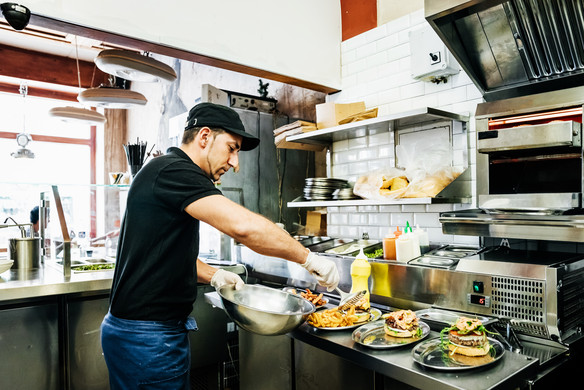Table of contents
Being adaptable and forward-looking are crucial qualities for success in the food and beverage business. In 2023, restaurateurs are navigating changes in foot traffic and consumer behavior, rising costs, and limited staff availability, among other challenges. According to the Square 2023 Future of Restaurants report, 99% of restaurateurs are planning tactics to weather a potential recession.
Only 29% of restaurateurs are considering raising prices in 2023 — more restaurants are exploring operational efficiencies and creative adaptations, like adding new revenue streams or switching up their menu offerings. While 88% of consumers reported they’ll be understanding if their favorite local businesses raise prices, food and beverage owners have a range of options when it comes to preparing for a potential economic downturn.
Use automation to increase staff efficiency.
The Square 2023 Future of Restaurants report found that 38% of restaurateurs are planning to automate tasks to increase staff efficiency. Automating tasks — like managing the influx of orders, whether they be online or in person — helps your staff stay organized and decreases long wait times and order errors. This creates a seamless customer experience for customers who continue to dine in your restaurant and can help increase customer loyalty.
Automating other back-of-house operations, such as tracking stock and creating vendor orders, can help you stay on top of your budget, maintain the vendor relationship, and stay ahead of any potential disruptions that can further complicate your business.
The Square Kitchen Display System can make fulfilling orders and handling inventory management simple and easy so that your restaurant runs smoothly and your staff works more efficiently.
Reduce dining room hours.
Reducing dining room hours is another way restaurants are planning to manage costs, with 36% of restaurateurs noting it as their plan. With working from home becoming a staple in the workforce, “lunchflation,”,and continued supply chain issues, the industry has seen a noticeable decline in diners eating out. In 2022, the average restaurant was open for 6.4 fewer hours per week than it was in 2019.
Reducing dining room hours during slower seasons or times of day can help to maximize your business by driving more traffic during limited hours. This can keep you from underutilizing your staff or losing perishable items in your kitchen, helping you better manage your staffing budget and preventing food waste.
Remember to market your new or adjusted hours with Square Marketing to let customers know when your restaurant is open.
Add non-core offerings.
Non-core offerings, such as retail options, frozen meal kits, or subscription services, are becoming increasingly popular at restaurants. With 35% planning to implement the option and over 50% of consumers purchasing retail items or premade frozen meals within the last year, this type of expansion is poised to see steady growth in the industry.
Creating additional store offerings diversifies revenue streams and grows your brand, giving customers more to be loyal to and more marketing opportunities that can expand your reach. Identify where your business could benefit most from expansion. Is there a slogan that would work great on a t-shirt? Is there a dish your customers love that could work as a premade frozen option? Consider ways you can bring ideas to life and do what’s best for your business.
Websites can make managing orders simple and easy for both aspects of your business by seamlessly integrating with any Square POS system so you can operate from a single, unified system.
Change up the menu.
While some restaurants are thinking about expanding their offerings, 33% are considering cutting back on menu offerings. While reviewing customer data can quickly tell you which dishes are most popular or least ordered, there are other factors that go into making tough cuts on restaurant menus.
Other deciding factors, like supply chain issues and reduced staffing, also play a role. If your restaurant has dishes that contain items that are consistently impacted by supply chain disruptions, it might be more effective to temporarily remove them from the menu until vendors can find more stability, or focus on items available locally. If there’s a dish that requires a lengthy cooking time and you’re working with a limited staff, consider removing the item from the menu to help free up your kitchen staff’s time to make other dishes.
Apply for a line of credit.
Opening a line of credit can be an integral part of getting a restaurant off the ground — and additional lines of credit can also be crucial to help maintain your business. Thirty percent of restaurateurs are considering expanding their use of credit in 2023. Staying current on financial tasks, including wages, property expenses, and more, is a crucial element to enduring an economic downturn and can help position you to grow once you reach the other side.
Square Banking has options to make managing your cash flow and seeking out additional funds easier. Doing away with outdated fees and applications, Square solutions can offer customized offers based on your sales with no ongoing interest and a simple flat fee. Understanding banking and credit options can be a common point of stress and confusion. Doing your research to understand your options and what they mean can make a world of difference for your business’s health and future.
Overcoming a potential recession may look like one or more of the above methods. Analyze the current state of your restaurant and determine a path that can support its needs. Be sure to talk to your staff about any changes that may impact them, and communicate with customers about any changes to your menu or hours of operation. For more trends or insight into how restaurants are handling the economy or preparing for the year, check out our 2023 Future of Restaurants report.
![]()











